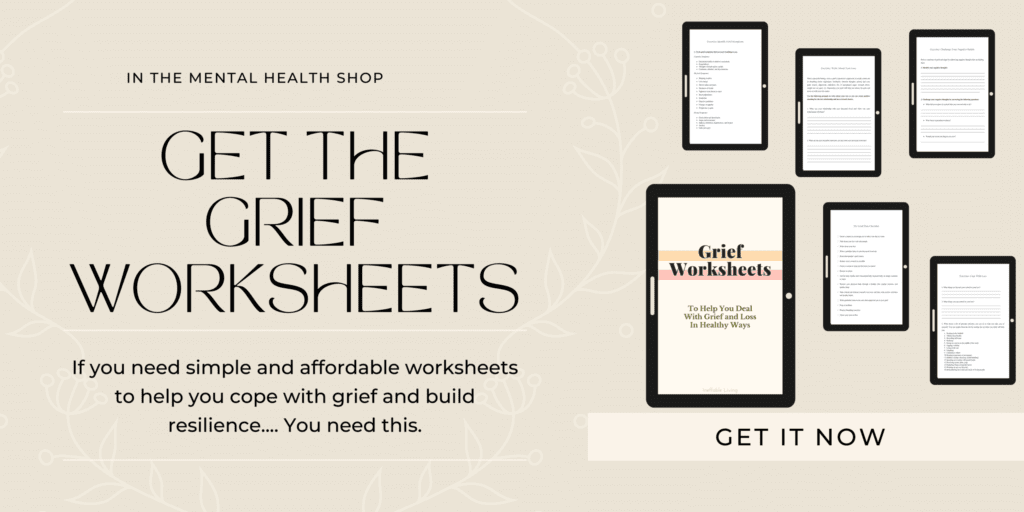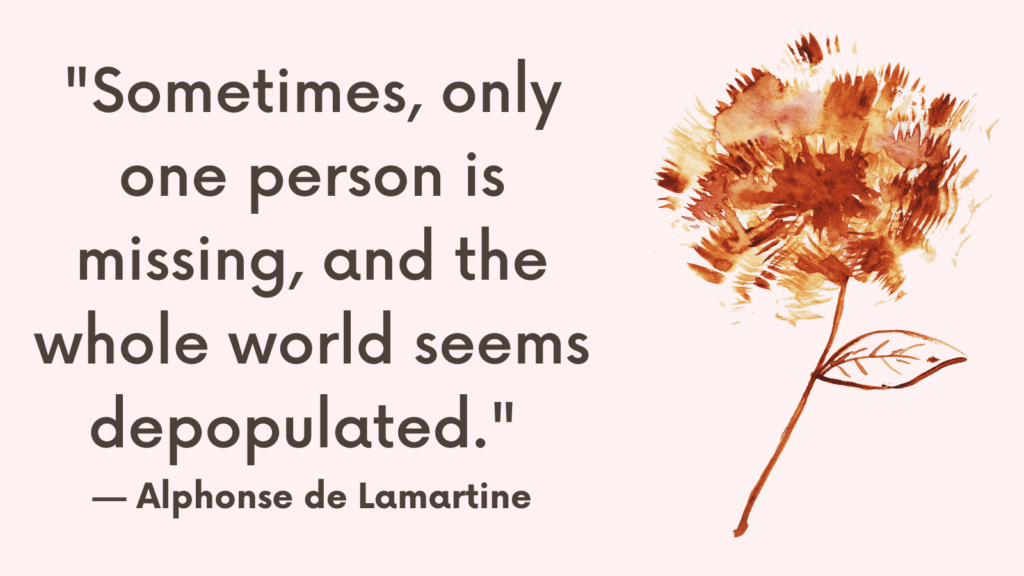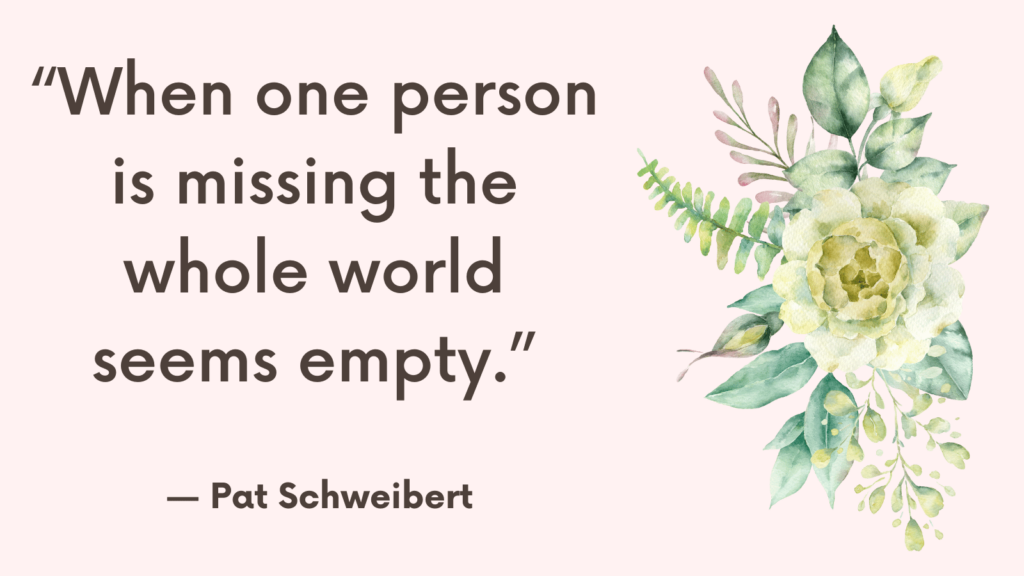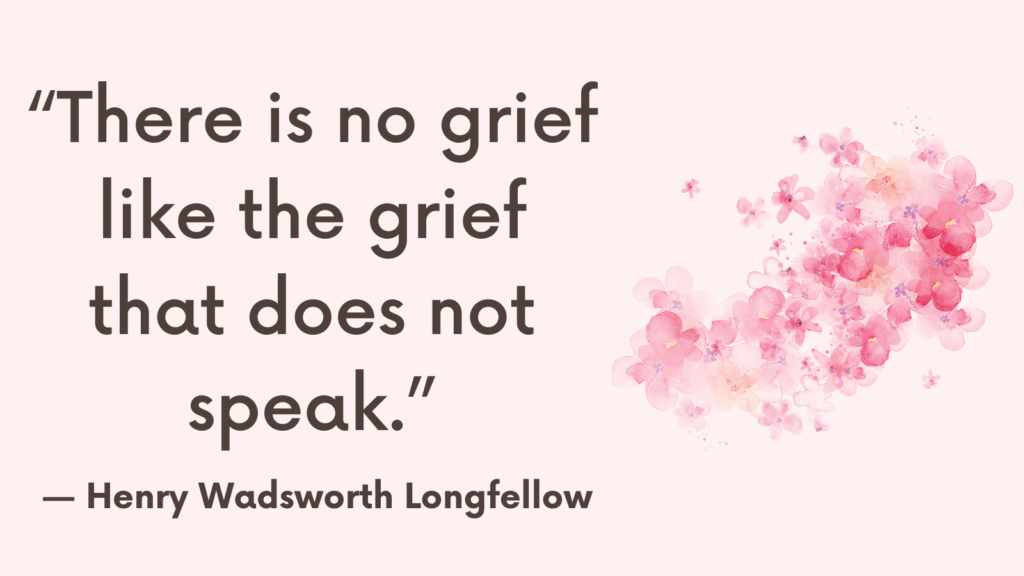In this article, you’ll learn all about stages of suicide grief and surviving suicide loss.
While suicide is just another name for death, the implications and stigma that surround it are strong enough to impact every aspect of our lives.
Suicide doesn’t just happen to the poor, the irresponsible, or the desperate. It can also happen to those with fulfilling careers, to the child, the sibling, the parent, the spouse, and the best friend. Suicide knows no boundaries.
As survivors of suicide, we find ourselves dealing not only with profound grief but also having to face misunderstandings when we desperately need unconditional support and compassion.
Although research indicates that grief of death by suicide is integrated at about the same pace as grief of any kind of death, there are different factors that can complicate grief, such as the natural question of “why?”, the trauma of discovering the suicide or witnessing it, the judgments and lack of support, etc.
The Language of Suicide
The words we employ to refer to suicide death are important.
More professionals are replacing phrases such as “complete,” or, “commit” with more neutral phrases like, “death by suicide,” or, “suicide.”
This is mainly because the word “commit” is often associated with sin.
Additional preferred terms for suicide may include: “killed himself,” “took his life,” “ended his own life.”
The phrase “completed suicide” can also be problematic as it often implies that there were multiple suicide attempts that preceded the actual death, which is not always the case.
The person who experiences the death of a family member or friend to suicide is often referred to as a “survivor.”
However, when talking about death, you want to use language that feels comfortable and right to you.
Grief of Death by Suicide Misconceptions
Misconception 1: Grief and mourning are the same things.
Many people use the words “grieving” and “mourning” interchangeably. But there is an important difference.
Grief is the internal thoughts and feelings you experience in response to a loss.
Mourning, on the other hand, is when you express those thoughts and feelings – the outward expression of grief. This may include, talking about your loss, crying, writing about your loss, etc.
It’s mourning that allows you to externalize your grief and move toward healing.
Related: Recovering From Grief: How to Get Back to Life After Loss
Misconception 2: Grief and mourning progress in predictable, orderly stages.
You have probably heard about the stages of grief popularized in 1969 with the publication of Elisabeth Kübler-Ross’s landmark text On Death and Dying.
These stages, initially intended for terminally ill patients’ experience of grief, include: denial; anger; bargaining; depression; and acceptance.
This notion of stages can make grief seem more predictable and less fearsome. However, these stages should not be interpreted as a rigid, linear sequence to be followed by all mourners.
Rather, allow yourself to be where you are and be patient with yourself when you feel like you’re oscillating between stages.
Misconception 3: You Need to determine the “whys?” of a suicide death to Find Closure.
Determining the “why” of someone’s death can help you make sense of things and find closure.
While this is a natural instinctive response to trauma loss, you can still live with the uncertainty of never fully knowing the answer and heal yourself.
Misconception 4: Only certain kinds of people end their lives.
Suicide doesn’t discriminate. People from all walks of life ended their lives since the beginning of recorded history.
Also, not all suicides were the result of a mental illness.
However, the American Association of Suicidology (AAS) states that approximately two-thirds of people who complete suicide are depressed.
Related: How to Heal Depression Without Medication? (10 Natural Depression Treatments)
Misconception 5. Suicide runs in the family.
Scientific research doesn’t show a genetic basis for suicide risk. However, mental illnesses such as depression disorders and substance abuse disorders may run in families.
If that’s the case, you can use this information to do what you can to reduce your risk or that of your loved ones, like educating yourself about the warning signs, avoiding alcohol and drugs, seeking professional help, etc.
Misconception 6: When You’re Finally Healed, grief will never come up again.
Just like stages of grief do not follow a linear sequence, grief can also come up as “griefbursts,” even after your loss is reconciled.
A sound, a smell, a name, or even a phrase can bring a wave of grief, though not as severe as the initial grief response.
Allow yourself to experience those griefbursts without self-judgment and acknowledge that this is a reminder of the love you had for the person who died.
Related: Dealing With Grief and Loss: 12 Lessons You Learn From Grief (+Grief Recovery Plan)
6 Stages Of Suicide Grief
Suicide grief does not follow Elisabeth Kubler-Ross’s Five Stages of Grief. Suicide grief is more complicated because it involves a labyrinth feelings of shame, guilt, confusion and other overwhelming emotions.
We cannot heal what we cannot feel.
Allowing yourself to feel your emotions and talking about them may not change what you are going through, but it will change you and change the way you see the world around you.
Feelings are not the problem, they constitute information and they are our way to reconstruct ourselves after the tragic loss we experienced.
Your journal can also be a good place to externalize your feelings and familiarize yourself with your unique grief journey.
Stage 1. Shock, Numbness, and Denial
When you first learned of the suicide, your initial reaction was probably being shocked that was later softened into numbness or denial.
It may feel like a dream that you’re waiting to wake up from.
The feelings of shock, numbness, and denial are nature’s way of protecting you from the reality of the sudden, tragic death.
They serve as a “psychological shock absorber” to help insulate you psychologically until you are more able to take in the reality of what happened.
Even though on one level you realize that the person is dead, on other levels, you are unwilling or even unable to believe it.
Even though feelings of shock, numbness, and denial subside as you begin to face and mourn your loss, they may resurface later on birthdays, anniversaries, holidays, or other special occasions as you realize that this person who was so much a part of your life is no longer there to celebrate with you.
How to Face These Feelings?
Acknowledge the role of sock, numbness, and denial in helping you survive your pain and allow yourself to experience them, without judgment.
Ease yourself into acknowledging the reality of suicide by talking about what happened with safe people, or writing about it. Pace yourself. You don’t have to face complete reality at once.
When talking or writing about your loss, saying the word suicide aloud can help you acknowledge reality.
Stage 2. Disorganization, Confusion, and Searching
These feelings arise as you begin to face the reality of your loss.
These feelings can also affect you physically and cognitively. You may find yourself unable to focus on one thing and experiencing forgetfulness and inability to complete tasks.
You may even feel like “you’re going crazy.”
Remind yourself that disorganization and confusion are normal parts of your grieving process.
How to Face These Feelings?
Recognize that these feelings are a normal reaction to a tragic experience.
Avoid judging yourself or interpreting your thought and feelings. Allow yourself to experience them and give them a voice.
Keeping your thoughts and feelings inside you will only make them more powerful. Share your experience with a safe person and write about them in your journal.
Take small steps to reduce your responsibilities and take care of yourself.
Given the judgment-making difficulties that usually come with grief, refrain from making any critical decision, such as moving to another location, quitting your job, etc.
Understanding Post-Traumatic Stress Disorder Ptsd
Post-traumatic stress disorder (PTSD) is a psychological condition that survivors of sudden, tragic death may experience.
Symptoms of PTSD may include nightmares and sleeping troubles, flashbacks, irritability or aggressive behavior, high levels of anxiety and panic attacks, etc.
While the suicide of a loved one is almost always a traumatic experience, not everyone will develop full-blown PTSD as a response.
Moreover, symptoms of suicide grief, and of PTSD can overlap with each other.
If you think you may be suffering from PTSD, consult with your family doctor or a trauma counselor.
Related: Recovering From Trauma and PTSD: 6 Practical Exercise to Support Healing After Trauma
Stage 3. Fear, Anxiety, and Panic
Given the tragic nature of death by suicide, you may find yourself experiencing feelings of fear, anxiety, and panic.
You may think to yourself, “Am I going to survive this? Will I be too overwhelmed that I, too, will take my own life? Will my life have any meaning without this person?”
These questions are a normal response when your sense of safety and security has been threatened.
However, if fearful thoughts of taking your own life persist, you need to see a professional mental health provider who can assist you.
Feelings of anxiety increase when you believe the fearful thoughts you’re having and let them outweigh any reassuring thoughts.
Therefore it’s important to recognize that these thoughts you’re experiencing are part of your grieving process and a natural and temporary response to the tragic loss you suffered.
Related: Anxiety Relief: How to Treat Anxious Symptoms and Thoughts Effectively?
How to Face These Feelings?
Make sure your fears and anxieties don’t go unexpressed.
Consider using some calming techniques like deep breathing exercises, grounding exercises, visualization, etc.
Write down your thoughts and try challenging them by answering the following questions:
· Do I have experiences that would contradict my beliefs in any way?
· What evidence do I have that what I believe is actually true?
· Am I falling into a thinking trap (e.g., catastrophizing or all-or-nothing treatment)?
· What would I tell a friend if he/she had the same thought?
· Am I confusing a belief with a fact?
· Am I basing my conclusion mostly on my feelings or on the true evidence?
Related: 10 Powerful Techniques To Control Your Negative Thoughts
Stage 4. Guilt, Regret, and Shame
While feelings of guilt, regret, and shame are common among survivors of suicide, they may not apply to you. So don’t let others project those feelings onto you by saying things like, “I bet you feel guilty about this.”
But in case you struggle with these feelings, you should know that you are not responsible for anyone’s decision to end their life. Only one person is responsible for suicide and that’s the person who did it.
It is natural for you to think about actions you could or could not have taken to prevent the death.
This is mainly because, as human beings, we fear uncertainty and would try everything to control all the events in our lives. The idea that much of what happens around us it cannot be controlled is difficult to accept.
If you find yourself having “if only” and “what if” thoughts, be compassionate with yourself. Recognize that these are normal reactions to a tragic and sudden death.
If these thoughts persist, you’ll need to address them and seek professional help.
Some suicide survivors may also experience embarrassment or shame as a result of imagined or actual gossip among neighbors, colleagues, and other social groups.
You need to remind yourself that you’re not responsible for the choice your loved one has made nor do you owe an explanation to anyone. Also, keep in mind that it is normal for others to be curious and wonder what happened.
How to Face These Feelings?
Don’t let your feelings of guilt, regret, and shame go unexpressed. Find a compassionate listener to share these thoughts with.
Related: How To Let Go Of Shame After Trauma?
Stage 5. Sadness, Depression, and Vulnerability
Although you may recognize that it’s natural for you to feel sad that someone you love is now gone, these feelings may seem frightening to you.
It’s always helpful to remind yourself that you have every right to feel sad, depressed, and vulnerable right now. These feelings are not a sign of weakness, or inability to cope, rather they are a sign that you loved and cared about this person.
These emotions may also be experienced in waves. One day you’re feeling hopeful, the next day you are in deep sadness.
How to Face These Feelings?
The best way to cope with these feelings is by embracing them and allowing them to be without judgment. Think of them as a cold winter that won’t last forever.
Your physical body is interconnected with your mind and emotions. Just as grief can impact you physically, you can also use your body to cope with grief.
Get enough rest, exercise regularly, and eat healthy food to build resilience.
Clinical Depression and Grief Depression
In many ways, clinical depression and grief depression are similar.
Commonly shared symptoms include lack of interest in usually pleasurable activities, hopelessness, and difficulty sleeping.
While grief depression is a normal and healthy response to a loss, clinical depression is not.
Grief depression softens over time, enabling you to get back to your life gradually, while clinical depression does not.
If you have concerns that you may be experiencing clinical depression, seek out professional help.
Stage 6. Relief And Release
It’s not uncommon for suicide survivors to feel a sense of relief and release after the suicide, especially when the person who ended their life has been suffering for a long time and/or has been threatening to end their life many times before the actual act.
Feeling relief doesn’t mean a lack of love or concern for the person who ended their life.
How to Face These Feelings?
Allow yourself to acknowledge your relief. Doing that can help you find hope in your healing.
Surviving Suicide Loss: How to Heal In Grief?
What is Healing in Grief?
To heal in grief refers to integrating your grief into yourself and becoming whole again.
By doing that, you learn how to continue to live your changed life fully and meaningfully.
Healing doesn’t happen to you. It requires that you actively engage in the work of mourning.
#1. Allow Yourself to Feel Your Loss
Allowing yourself to feel your loss means giving it the attention it demands. This is not a self-destructive act, rather it’s a life-giving act.
Only when you allow yourself to feel your grief, that you can heal it.
This is not always easy to do.
In our culture, pain and grief are feelings most people try to avoid.
This is mainly due to misunderstandings around the role of pain. Most of us share the misconception that pain is wrong and should be avoided.
But emotions in general are feedback about what’s going on within and around us. They’re also our body’s way to heal us. Sadness, for example, helps you slow down and reflect on what happened, make sense of the events so you can make necessary changes and move on.
Moreover, unless you open yourself to your loss, the pain of suicide grief will keep trying to get your attention, sometimes in ugly ways, such as panic attacks, addictions, etc.
In this sense, the alternatives—denying, suppressing, or avoiding your pain—are in fact more painful.
Related: Stop Self-Sabotage: How to Tame Your Inner Teenager and Heal Your Inner Child?
#2. Set The Intention to Heal
Your intention directly influences your inner thoughts, beliefs, and reality.
You might tell yourself, “I can and will survive this profound loss. I can and will reach out for support.”
By setting an intention to heal, you actively guide your grief and commit to actively mourn your loss.

#3. Understand the Concept of Surrender
Surrendering or radically accepting a certain situation means to stop resisting it or wishing the past was different. It is only when we surrender, that things begin to change.
Surrendering does mean you like it or you want it. It means that you stop trying to push away or deny your pain – something that will only complicate your grief.
When you surrender, you acknowledge, “This is what I’m facing right now. While I’d like it to be different, I need to face the reality of what is happening if I want to suffer less and move on sooner.”
#4. Take it One Day at a Time
Healing in grief does not happen quickly and cannot be done efficiently.
Although grief requires active mourning, you are probably struggling with “grief lethargy” that leaves you feeling drained physically, emotionally, and spiritually.
Therefore, you need to be patient with yourself. Trust that the pain will not last forever and that it will gradually become more tolerable.
The healthy way to approach grief work is to work at (feeling the pain of your grief), and surrender to (stop fighting or denying the reality) your grief, both at the same time.
#5. “Dose” Your Pain
Although the only way to heal in grief is to allow yourself to feel the pain of your suicide grief, you need to recognize that you cannot embrace the pain all at once.
You need to allow yourself to feel your pain in small waves so you won’t feel overwhelmed.
This is done by using distractions every now and then. You may focus on getting things done or practicing pleasurable activities.
#6. Recognize the Difference Between Shock and Denial
Shock is a temporary, healthy response to profound loss, such as a death by suicide.
The reality of the suicide death of a loved one is too painful to acknowledge at once.
Denial can take many forms when it comes to grieving death by suicide:
- You may consciously choose to hide the fact that the death was caused by suicide and instead tell people that it was a heart attack or a stroke.
- You may find yourself holding onto the hope that the findings that ruled the death a suicide were wrong and will be corrected sometime later.
- You may blame someone else to deny that the person took his own life by choice.
- You may avoid talking about the death or avoid using words like “suicide” with your family or close friends.
Denial here helps you take in the reality of what happened gradually. However, when you stay in long-term denial, you may hinder your healing and complicate your grief.
#7. Face Inappropriate Expectations
Societal messages such as “be strong,” or, “keep busy,” or, “keep your chin up,” can be unhelpful, further stigmatizing grief in general and suicide grief in particular.
Society has it backwards in defining who is “doing well” in grief and who is “not doing well.”
– Alan D. Wolfelt
Being aware of these inappropriate expectations and misconceptions can help you face them without allowing them to hinder your grief process and healing.
Realistic Expectations for Grief
• You may naturally feel the emotion of grief, but you will have to make a conscious effort to mourn.
• Your grief and mourning will impact you physically, emotionally, cognitively, socially, and spiritually.
• You need to allow yourself to feel your emotions and externalize them to heal.
• Your grief will be unpredictable and you may find yourself oscillating between different stages of grief.
• You don’t “overcome” grief; you learn to live with it.
• You will not always feel this bad.
#8. Acknowledge Secondary Losses, too
When someone you love ends their life, you lose more than the physical presence of that person.
These are called “secondary losses.” Examples may include:
- Loss of sense of identity: You may have to rethink your role as a spouse or a parent or a best friend.
- Loss of emotional and/or physical security: You may feel unsafe being at home without your loved one.
- Loss of financial security: You may face financial problems.
- Loss of lifestyle and routine: The person who died by suicide may have been an important part of your daily life and losing him will impact even your routines and lifestyle.
- Loss of dreams for the future: If you share hopes and dreams for the future with the person, you will find yourself having to rethink them.
- Loss of faith: You may find yourself questioning your faith.
- Etc.
Acknowledging the different levels of loss of suicide death will help you move forward on your unique grief journey.
#9. Get Support
Mourning the suicide death of your loved one requires support from others.
Keep in mind that when it comes to suicide and grief in general many people don’t know how to support you. Many people in your life may even pull away.
The good news is that one supportive, compassionate person can make a huge difference and help you survive this.
Find a safe family member, friend, or compassionate counselor and ask for their support.
For many people, it’s asking for support is a challenging task, especially when they’re grieving.
#10. Practice Self-Care
Simple self-care practices like eating healthy food, exercising, following a sleeping schedule, reducing your stress, can be the best things you can do to lay the foundation for your healing in grief.
This can be challenging because grief can leave you feeling drained and exhausted. Even getting out of bed can feel like a challenge.
Make a commitment to take care of yourself even in small ways.
Free Printable Worksheets For Grief (PDF)
Conclusion
Grief that accompanies suicide can be a life-changing experience, allowing yourself to feel grief and mourn your loss will help facilitate your own healing.
References
- Portions of this article were adapted from the book Understanding Your Suicide Grief: Ten Essential Touchstones for Finding Hope and Healing Your Heart, © 2004 by Alan Wolfelt. All rights reserved.
- Effectiveness of interventions for people bereaved through suicide: a systematic review of controlled studies of grief, psychosocial and suicide-related outcomes | BMC Psychiatry | Full Text (biomedcentral.com)
- Suicide bereavement and complicated grief – PMC (nih.gov)
- Frontiers | Editorial: Grief After Suicide: A Health Perspective on Needs, Effective Help, and Personal Growth | Psychology (frontiersin.org)
- Frontiers | Lessons Learned: Forty Years of Clinical Work With Suicide Loss Survivors | Psychology (frontiersin.org)
- Grief interventions for people bereaved by suicide: A systematic review | PLOS ONE
- Exploring the Support Needs of People Bereaved by Suicide: A Qualitative Study – Victoria Ross, Kairi Kõlves, Diego De Leo, 2021 (sagepub.com)
- The relationship between guilt, depression, prolonged grief, and posttraumatic stress symptoms after suicide bereavement – Wagner – 2021 – Journal of Clinical Psychology – Wiley Online Library
- What are the physical and psychological health effects of suicide bereavement on family members? An observational and interview mixed-methods study in Ireland | BMJ Open
- UCL Bereavement Study | Psychiatry – UCL – University College London
- Suicide Bereavement and Complicated Grief – The Center for Prolonged Grief (columbia.edu)




